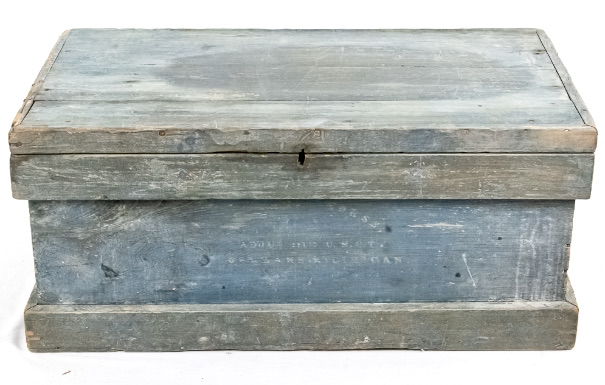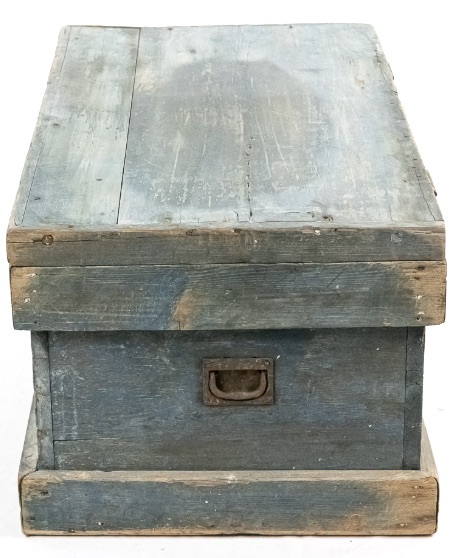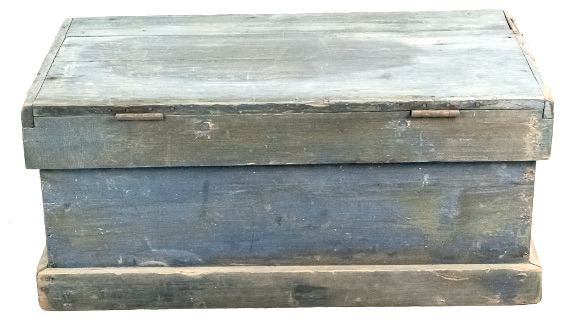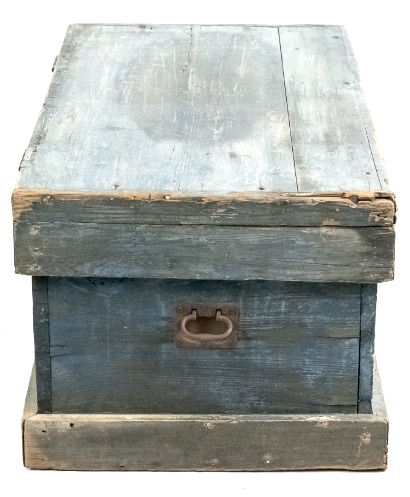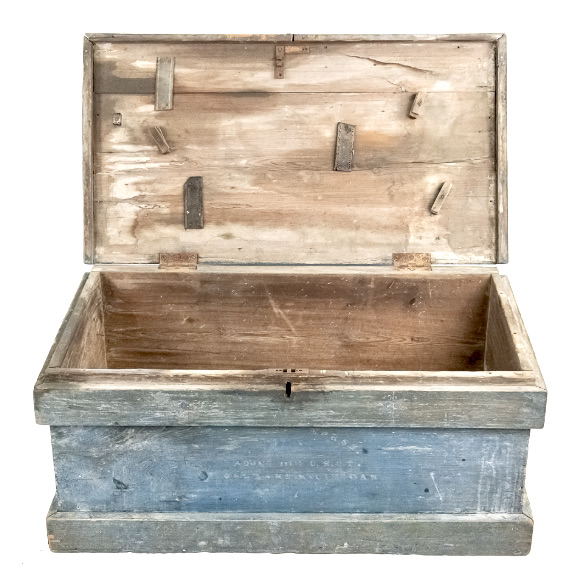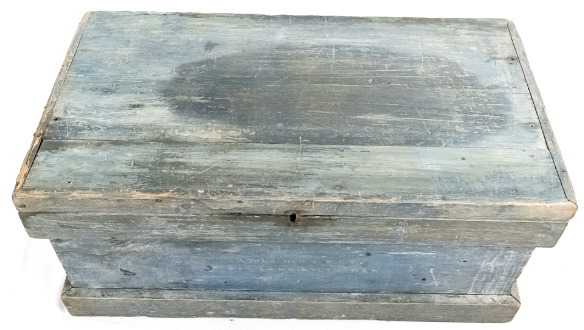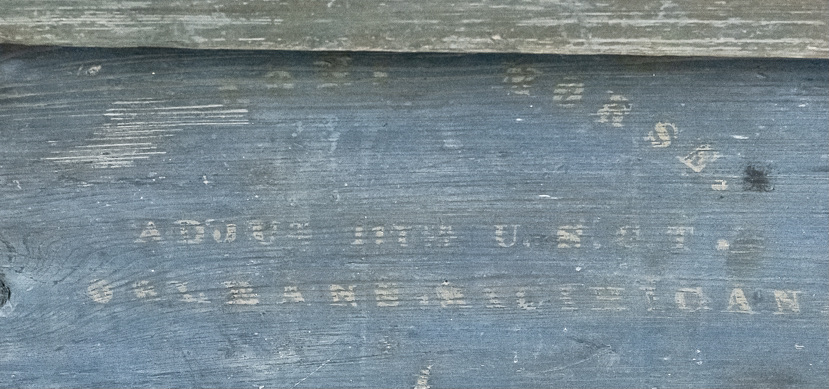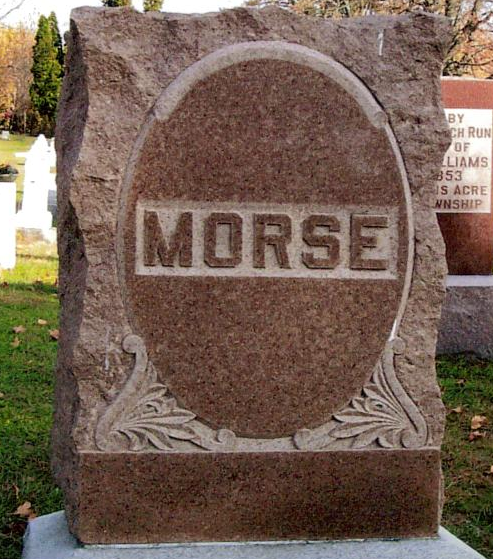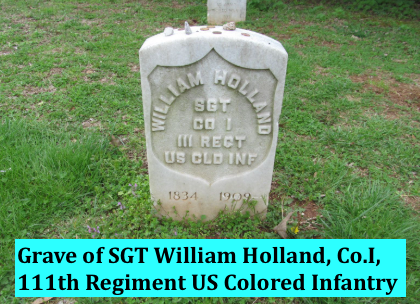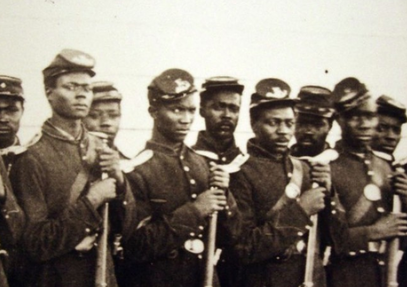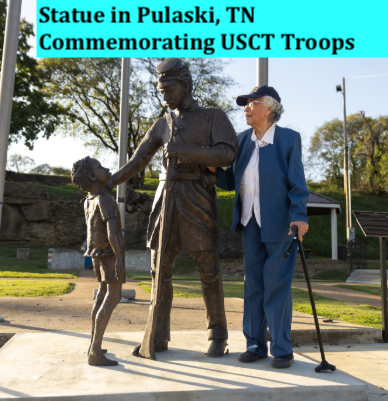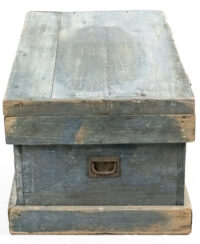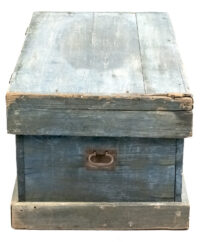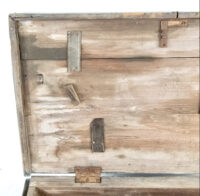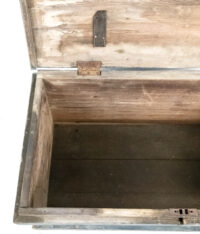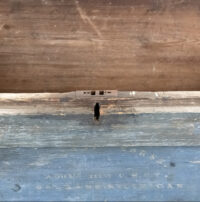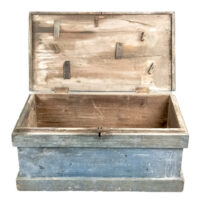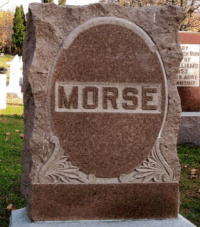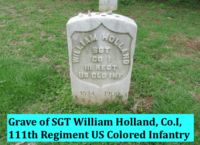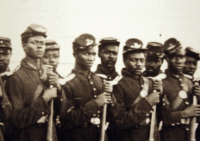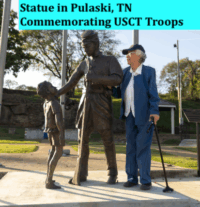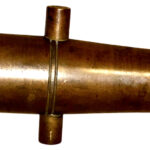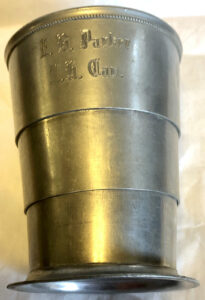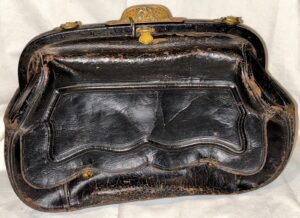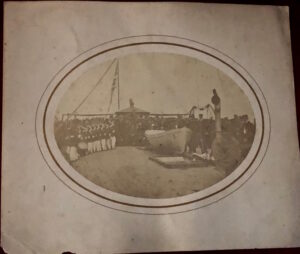Id’d Civil War Camp Trunk – Jason Morse, Adjutant of the 111th USCT
$1,750
Id’d Civil War Camp Trunk – Jason Morse, Adjutant of the 111th USCT – This substantially constructed, white pine chest, retains 80% + of its original light blue paint and remains in overall very good condition; there are some period water stains and minor discoloration from field use. Stenciled in white, on the front of the chest, is the following:
“JASON MORSE
ADJUT 111th U.S.C.T.
ORLEANS, MICHIGAN”
The trunk has its original lock and has iron, carrying handles at each end of the trunk. On the interior side of the lid are several brackets of wood and leather, perhaps for holding tools. At either end of the trunk’s exterior are iron, folding handles. The trunk remains in overall very good condition, with all of the wood in strong shape. Jason Morse, with the 9th Michigan, spent a considerable amount of time on provost duty in the Nashville and Pulaski areas; apparently at some point, Morse volunteered to become the adjutant for the 111th USCT stationed in Pulaski.
The 3rd Alabama Infantry, composed of many ex-slaves, was organized at Pulaski, Tenn., January 3, 1864 and was subsequently attached to the Federal garrison at Pulaski, as a regiment in the Army Department of Tennessee and would remain in Pulaski through June, 1864, serving garrison duty there and Athens, as well as guards to railroads in Northern Alabama. The 3rd Alabama designation was changed to the 111th U.S. Colored Troops on June 25, 1864. During the Civil War, Pulaski, Tennessee, played a significant role in the organization and deployment of Black soldiers, specifically the 110th and 111th Regiments of the U.S. Colored Troops (U.S.C.T.). These regiments were primarily composed of men who had lived in slavery and were recruited from Giles County and surrounding areas in Tennessee, Alabama, and Mississippi. These troops were instrumental in defending against Confederate forces and served with distinction in battles like Nashville, even enduring hardships and captivity during the war.
Measurements: L – 31.25″; W – 14″; H – 11″; weight – approx. 70 – 75 lbs.
Jason Morse
Residence was not listed; 18 years old.
Enlisted on 9/8/1864 at Marshall, MI as a Priv.
On 9/8/1864, he mustered into “D” Co. Michigan 9th Infantry.
He was disch on 6/20/1865 at Nashville, TN
He was listed as:
- Joined regiment 10/26/1864 (place not stated)
Born in 1846
Died in 1911
Buried: Birch Run Twp Cemetery, Birch Run, Saginaw Co., MI
After the war, he lived in Saginaw County, M
| Name: | Jason
Morse |
| Enlistment Age: | 18 |
| Birth Date: | 1846 |
| Enlistment Date: | 8 Sep 1864 |
| Enlistment Place: | Marshall, Michigan |
| Enlistment Rank: | Private |
| Muster Date: | 8 Sep 1864 |
| Muster Place: | Michigan |
| Muster Company: | D |
| Muster Regiment: | 9th Infantry |
| Muster Regiment Type: | Infantry |
| Muster Information: | Enlisted |
| Muster Out Date: | 20 Jun 1865 |
| Muster Out Place: | Nashville, Tennessee |
| Muster Out Information: | disch |
| Side of War: | Union |
| Survived War?: | Yes |
| Last Known Residence Place: | Saginaw County, Michigan |
| Death Date: | 1911 |
| Burial Place: | Birch Run, Saginaw Co., Michigan |
| Notes: | 1864-10-26 Joined regiment |
Jason Clark Morse
Birth
13 Apr 1846
New York, USA
Death
30 Jul 1911 (aged 65)
Saginaw, Saginaw County, Michigan, USA
Burial
Birch Run, Saginaw County, Michigan, USA
Jason Morse – CIVIL WAR SOLDIER
CO D 9TH MICHIGAN INFANTRY PVT
Enlisted September 9, 1864
Discharged June 20, 1865
Member – GAR Grand Army of the Republic
9th MI Infantry
Organized: Detroit, MI on 10/15/1861
Mustered out: 9/15/1865
MICHIGAN Ninth Infantry. (Three Years) The Ninth Infantry was organized at Fort Wayne, near Detroit, and was mustered into the U. S. service Oct. 15, 1861, with an enrollment of 913 officers and men. Immediately upon its completion the regiment was ordered to Kentucky and was one of the first Michigan regiments to report for duty in the western department. The field, staff, and line officers of the Ninth at organization were as follows: William W. Duffield, Detroit, Colonel. John G. Parkhurst, Coldwater, LieutenantColonel. Dorus M. Fox, Lyons, Major.—– ,—– , Surgeon. Cyrus Smith, Jackson, Assistant Surgeon. Henry M. Duffield, Detroit, Adjutant, Charles H. Irwin, Detroit, Quartermaster. James G. Portman, Lyons, Chaplain. A. Captain, William Wilkinson, Romeo. First Lieutenant, Albert Nye, Mt. Clemens. Second Lieutenant, Hiram Barrows, Romeo. B. Captain, Oliver C. Rounds, Niles. First Lieutenant, Moses A. Powell, Niles. Second Lieutenant, Leonard J. Wright, Niles. C. Captain, Charles V. Deland, Jackson. First Lieutenant, Joseph H. Iott, Jackson. Second Lieutenant, J. Curtis Purdy, Jackson. D. Captain, John E. Smith, Lyons. First Lieutenant, Daniel C. Moore, Lyons. Second Lieutenant, James N. Wallace, Lyons. E. Captain, Cyprian H. Millard, Linden. First Lieutenant, Moses A. Share, Detroit. Second Lieutenant, Stephen S. Barrows, Detroit. F. Captain, George K. Newcombe, Owosso. First Lieutenant, Samuel S. Bangs, Marshall, Second Lieutenant, Ephraim Marble, Marshall. G. Captain, George N. Chase, Detroit. First Lieutenant, Mortimer Mansfield, Coldwater. Second Lieutenant, William A. Hull, Coldwater. H. Captain, Andrew M. Adams, Detroit. First Lieutenant, Samuel A. Wiggins, Detroit. Second Lieutenant, Charles T. Fox, Lyons. I. Captain, William Jenney, Jr., Mt. Clemens. First Lieutenant, Blake W. Hornbeck, Detroit. Second Lieutenant, Alanson P. Dickinson, Romeo. K. Captain, John A. Tanner, Fowlerville. First Lieutenant, Thomas J. Conely, Jackson. Second Lieutenant, Lewis V. Curry, Brighton. In November 1861, the regiment was at West Point, Ky., where it assisted in fortifying Muldraugh Hill and building roads and bridges. Detachments of the Ninth were sent to Elizabethtown and other places from West Point, where their presence was necessary to gain information and protect the country from the enemy. Colonel W. W. Duffield, having been assigned to command the Twenty-third Brigade, Army of tile Cumberland, Lieutenant Colonel John J. Parkhurst assumed command of the Ninth and assembled his regiment at West Point, where it embarked on the Ohio river and proceeded to Nashville, where it arrived Jan. 23, 1862. The regiment participated in the march through Kentucky after the confederate General John Morgan and the Twenty-third Brigade assisted largely in driving the notorious raider from the state. In June the Ninth formed a portion of a force of 5,00 troops under command of General Negley, and commenced a movement to capture Chattanooga, Tenn. After numerous conflicts with the enemy, Negley’s troops arrived before Chattanooga June 8, and after a spirited contest drove the enemy out of the city. Not having a force sufficient to occupy and hold the works, General Negley divided his forces and placed them at strategic points in the vicinity. In July four of the companies under Major Dorus M. Fox were stationed at Tullahoma and the other six companies were under the command of Lieutenant Colonel Parkhurst at Murfreesboro. Here the six companies of the Ninth, together with the Third Minnesota and a squadron of Kentucky cavalry were furiously atacked by the confederate General Forest at four o’clock in the morning of July 13, by a force of 2,500 cavalry. The attack fell heavily upon the detachment of the Ninth, consisting of about 250 men. The enemy rode with reckless bravery into the camp of the Ninth, when a hand to hand encounter took place, and after a prolonged struggle the enemy was driven back and tile camp recovered. No support was sent to the Ninth, though Lieutenant Colonel Parkhurst sent messengers to tile commander of the post, calling for re- enforcements and describing his desperate condition. The isolated position of the detachment of the Ninth furnished ample opportunity to Forest to bring an overwhelming force against it. The obstinate contest lasted from four a.m. until one p.m. when with no prospect of aid, with one-third of his men killed, wounded or captured, Lieutenant Colonel Parkhurst was most reluctantly obliged to surrender his command to the enemy. Lieutenant Colonel Parkhurst and his Adjutant Henry M. Duffield were taken prisoners in this engagement, and the former was held until Dec. 3 1862, when he was released and the latter Aug. 15, 1862. During the month of November the Ninth entered upon the campaign under General Rosecrans, who was operating against the enemy and culminated in the battle of Stone River and capture of Murfreesboro. During this campaign and before the battle of Stone River the Ninth was detailed by General Thomas as a special guard at his headquarters and Provost Guard for the Fourteenth Corps. When the Union right was crushed at Stone River the Ninth did most gallant service in checking the stampede to the rear, and by firmly holding the Nashville pike tile disorganized forces were stopped and returned to their commands. Major General Thomas complimented Colonel Parkhurst and tile regiment for the very important service rendered at this critical point of the battle. The regiment was engaged in provost duty at Chickamauga, Ga., and by its prompt action gathered up the stragglers from the commands that were broken up by the furious onsets of the enemy and returned them to the firing line, where they helped to repel the confederates. Lieutenant Colonel Parkhurst was commissioned Colonel Feb. 6, 1863, and made Provost Marshall General of the Army of the Cumberland with Lieutenant H. M. Duffield as his Adjutant General. The regiment passed under the command of Colonel Wilkinson, and in November and December the Ninth was doing provost duty at Chattanooga. Here the regiment veteranized, 306 of the men re- enlisting, and were sent to Coldwater, Mich., and furloughed for 30 days. After the expiration of the 30 days furlough the regiment left Coldwater Feb. 10, 1864, with 500 men and reported to General Thomas and started on the Georgia Campaign. It was on provost duty in all the battles between Chattanooga and Atlanta and when Atlanta fell, did provost duty in that city. The Ninth returned to Chattanooga and then proceeded to Nashville with General Thomas performing provost duty until Sept. 15, 1865, when it was mustered out and returned to Michigan, where it arrived on the 27th and was paid off and disbanded at Jackson. The regiment participated in engagements at Murfreesboro, Tenn., July 13, 1862, Lavergne Tenn., December 27, 1862; Stone River, Tenn., December 29 to 31, 1862 January 1 and 2, 1863; Chickamauga, Ga., September 19 and 20, 1863, Mission Ridge, Tenn., November 25, 1863; Rocky Face, Ga., May 8, ,1864; Resaca, Ga., May 14,1864; Dallas, Ga., May 27, 1864; Kenesaw, Ga., June 25, 1864, Chattahoochee River, Ga., July 5 and 6, 1864; siege of Atlanta, Ga., July 22 to August 25, 1864; Jonesboro, Ga., September 1, 1864. Total enrollment ………………………………….1,947 Killed in action …………………………………….14 Died of wounds ………………………………………11 Died of disease …………………………………….271 Discharged for disability (wounds and disease) …………208
UNITED STATES COLORED TROOPS
111th Regiment, United States Colored Infantry
Overview:
Organized June 25, 1864, from 3rd Alabama Colored Infantry. Attached to garrison at Pulaski, Tenn., District of North Alabama, Dept. of the Cumberland, to February, 1865. Defences of Nashville & Northwestern Railroad, Dept. of the Cumberland, to March, 1865. 3rd Sub-District, District of Middle Tennessee, to July, 1865. Dept. of the Tennessee to April, 1866.
Service:
Duty at Pulaski, Tenn., and Athens, Ala., District of North Alabama, till September, 1864. Action at Athens with Forest September 23-24 (most of Regiment captured). Sulphur Branch Trestle September 25 (Detachment). Duty at Pulaski, Tenn., till January, 1865. Guard duty on Nashville & Northwestern Railroad and in Middle Tennessee till April, 1866. Mustered out April 30, 1866.
Predecessor unit:
ALABAMA VOLUNTEERS.
3rd REGIMENT INFANTRY.
Organized at Pulaski, Tenn., January 3, 1864. Attached to Garrison of Pulaski, Tenn., Dept. Tennessee, to June, 1864.
Garrison duty at Pulaski and Athens and as guard to Railroads in Northern Alabama till June, 1864.
Designation changed to 111th U.S. Colored Troops June 25, 1864, which see.
111th United States Colored Infantry Regiment
| 3rd Alabama Volunteer Infantry Regiment (African Descent) |
|
| Active | January 3, 1864–June 25, 1864 |
| Disbanded | June 25, 1864 |
| Country | United States |
| Allegiance | Union |
| Branch | Infantry |
| Size | Regiment |
| Garrison/HQ | Pulaski, Tennessee Athens, Alabama |
| Engagements | American Civil War |
The 3rd Alabama Volunteer Infantry Regiment (African Descent) was an infantry regiment that served in the Union Army between January 3, 1864, and June 25, 1864, during the American Civil War.
Service
The infantry regiment was organized at Pulaski, Tennessee, on January 3, 1864. Straight away it was placed on garrison duty at Pulaski and Athens, Alabama. While they were on garrison duty they were attached to the Department of Tennessee. In the meantime, they acted as guard for railroads into Northern Alabama until June 25, 1864. On June 25, 1864, the regiment was designated the 111th U.S. Regiment Colored Troops.

